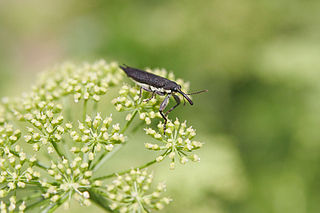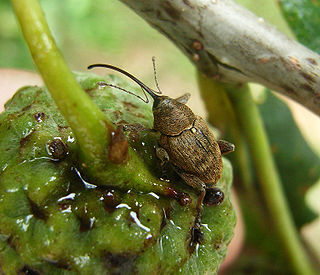Related Research Articles

In biology, coevolution occurs when two or more species reciprocally affect each other's evolution through the process of natural selection. The term sometimes is used for two traits in the same species affecting each other's evolution, as well as gene-culture coevolution.

In ecology, a biological interaction is the effect that a pair of organisms living together in a community have on each other. They can be either of the same species, or of different species. These effects may be short-term, like pollination and predation, or long-term; both often strongly influence the evolution of the species involved. A long-term interaction is called a symbiosis. Symbioses range from mutualism, beneficial to both partners, to competition, harmful to both partners. Interactions can be indirect, through intermediaries such as shared resources or common enemies. This type of relationship can be shown by net effect based on individual effects on both organisms arising out of relationship.

Passiflora edulis, commonly known as passion fruit, is a vine species of passion flower native to southern Brazil through Paraguay and northern Argentina. It is cultivated commercially in tropical and subtropical areas for its sweet, seedy fruit. The fruit is a pepo, a type of berry, round to oval, either yellow or dark purple at maturity, with a soft to firm, juicy interior filled with numerous seeds. The fruit is both eaten and juiced, the juice often added to other fruit juices to enhance aroma.

Weevils are beetles belonging to the superfamily Curculionoidea, known for their elongated snouts. They are usually small, less than 6 mm in length, and herbivorous. Approximately 97,000 species of weevils are known. They belong to several families, with most of them in the family Curculionidae. Some other beetles, although not closely related, bear the name "weevil", such as the biscuit weevil, which belongs to the family Ptinidae.

Conium is a genus of flowering plants in the family Apiaceae. As of December 2020, Plants of the World Online accepts six species.
The Prodoxidae are a family of moths, generally small in size and nondescript in appearance. They include species of moderate pest status, such as the currant shoot borer, and others of considerable ecological and evolutionary interest, such as various species of "yucca moths".

Dehiscence is the splitting of a mature plant structure along a built-in line of weakness in order to release its contents. This is common among fruits, anthers and sporangia. Sometimes this involves the complete detachment of a part; structures that open in this way are said to be dehiscent. Structures that do not open in this way are called indehiscent, and rely on other mechanisms such as decay or predation to release the contents.
Herbivores are dependent on plants for food, and have coevolved mechanisms to obtain this food despite the evolution of a diverse arsenal of plant defenses against herbivory. Herbivore adaptations to plant defense have been likened to "offensive traits" and consist of those traits that allow for increased feeding and use of a host. Plants, on the other hand, protect their resources for use in growth and reproduction, by limiting the ability of herbivores to eat them. Relationships between herbivores and their host plants often results in reciprocal evolutionary change. When a herbivore eats a plant it selects for plants that can mount a defensive response, whether the response is incorporated biochemically or physically, or induced as a counterattack. In cases where this relationship demonstrates "specificity", and "reciprocity", the species are thought to have coevolved. The escape and radiation mechanisms for coevolution, presents the idea that adaptations in herbivores and their host plants, has been the driving force behind speciation. The coevolution that occurs between plants and herbivores that ultimately results in the speciation of both can be further explained by the Red Queen hypothesis. This hypothesis states that competitive success and failure evolve back and forth through organizational learning. The act of an organism facing competition with another organism ultimately leads to an increase in the organism's performance due to selection. This increase in competitive success then forces the competing organism to increase its performance through selection as well, thus creating an "arms race" between the two species. Herbivores evolve due to plant defenses because plants must increase their competitive performance first due to herbivore competitive success.

Curculio glandium is a species of European carpophagus weevil in the genus Curculio, the acorn and nut weevils. It eats by a rostrum, an elongated snout, that is used for piercing.

Tomato mosaic virus (ToMV) is a plant pathogenic virus. It is found worldwide and affects tomatoes and many other plants.

Oncopeltus fasciatus, known as the large milkweed bug, is a medium-sized hemipteran of the family Lygaeidae. It is distributed throughout North America, from Central America through Mexico and the Caribbean to southern areas in Canada. Costa Rica represents this insect's southern limit. It inhabits disturbed areas, roadsides, and open pastures. Due to this widespread geographic distribution, this insect exhibits varying life history trade-offs depending on the population location, including differences in wing length and other traits based on location.

Angraecum sesquipedale, also known as Darwin's orchid, Christmas orchid, Star of Bethlehem orchid, and king of the angraecums, is an epiphytic orchid in the genus Angraecum endemic to Madagascar. The orchid was first discovered by the French botanist Louis-Marie Aubert du Petit-Thouars in 1798, but was not described until 1822. It is noteworthy for its long spur and its association with the naturalist Charles Darwin, who surmised that the flower was pollinated by a then undiscovered moth with a proboscis whose length was unprecedented at the time. His prediction had gone unverified until 21 years after his death, when the moth was discovered and his conjecture vindicated. The story of its postulated pollinator has come to be seen as one of the celebrated predictions of the theory of evolution.

Fruit anatomy is the plant anatomy of the internal structure of fruit. Fruits are the mature ovary or ovaries of one or more flowers. They are found in three main anatomical categories: aggregate fruits, multiple fruits, and simple fruits. Aggregate fruits are formed from a single compound flower and contain many ovaries or fruitlets. Examples include raspberries and blackberries. Multiple fruits are formed from the fused ovaries of multiple flowers or inflorescence. Examples include fig, mulberry, and pineapple.

Upiga is a monotypic moth genus described by Hahn William Capps in 1964. The genus is placed in the family Crambidae, but has also been placed in Pyralidae. It contains only one species, Upiga virescens, the senita moth, described by George Duryea Hulst in 1900 and found in the Sonoran Desert of North America.

Host–parasite coevolution is a special case of coevolution, where a host and a parasite continually adapt to each other. This can create an evolutionary arms race between them. A more benign possibility is of an evolutionary trade-off between transmission and virulence in the parasite, as if it kills its host too quickly, the parasite will not be able to reproduce either. Another theory, the Red Queen hypothesis, proposes that since both host and parasite have to keep on evolving to keep up with each other, and since sexual reproduction continually creates new combinations of genes, parasitism favours sexual reproduction in the host.

Ecological fitting is "the process whereby organisms colonize and persist in novel environments, use novel resources or form novel associations with other species as a result of the suites of traits that they carry at the time they encounter the novel condition". It can be understood as a situation in which a species' interactions with its biotic and abiotic environment seem to indicate a history of coevolution, when in actuality the relevant traits evolved in response to a different set of biotic and abiotic conditions.

Evolving digital ecological networks are webs of interacting, self-replicating, and evolving computer programs that experience the same major ecological interactions as biological organisms. Despite being computational, these programs evolve quickly in an open-ended way, and starting from only one or two ancestral organisms, the formation of ecological networks can be observed in real-time by tracking interactions between the constantly evolving organism phenotypes. These phenotypes may be defined by combinations of logical computations that digital organisms perform and by expressed behaviors that have evolved. The types and outcomes of interactions between phenotypes are determined by task overlap for logic-defined phenotypes and by responses to encounters in the case of behavioral phenotypes. Biologists use these evolving networks to study active and fundamental topics within evolutionary ecology.

Escape and radiate coevolution is a hypothesis proposing that a coevolutionary 'arms-race' between primary producers and their consumers contributes to the diversification of species by accelerating speciation rates. The hypothesized process involves the evolution of novel defenses in the host, allowing it to "escape" and then "radiate" into differing species.
Exploitative interactions, also known as enemy–victim interactions, is a part of consumer–resource interactions where one organism is the consumer of another organism, typically in a harmful manner. Some examples of this include predator–prey interactions, host–pathogen interactions, and brood parasitism.
John Norton Thompson is an American evolutionary biologist.
References
- 1 2 Thompson, John N. (24 December 2005). "Coevolution: The Geographic Mosaic of Coevolutionary Arms Races". Current Biology. 15 (24): R992–R994. doi: 10.1016/j.cub.2005.11.046 . PMID 16360677. S2CID 16874487.
- 1 2 3 Gomulkiewicz, Richard; Thompson, John N.; Holt, Robert D.; Nuismer, Scott L.; Hochberg, Michael E. (1 August 2000). "Hot Spots, Cold Spots, and the Geographic Mosaic Theory of Coevolution". The American Naturalist. 156 (2): 156–174. doi:10.1086/303382. PMID 10856199. S2CID 4442185.
- 1 2 3 Anderson, Bruce; Johnson, Steven D. (2008). "The Geographical Mosaic of Coevolution in a Plant–Pollinator Mutualism". Evolution. 62 (1): 220–225. doi: 10.1111/j.1558-5646.2007.00275.x . PMID 18067570. S2CID 8643749.
- ↑ Arnold, Trevor H. (1993). Plants of Southern Africa: Names and Distribution. National Botanical Institute. ISBN 978-1-874907-03-9.[ page needed ]
- 1 2 Toju, Hirokazu; Sota, Teiji (January 2006). "Imbalance of Predator and Prey Armament: Geographic Clines in Phenotypic Interface and Natural Selection". The American Naturalist. 167 (1): 105–117. doi:10.1086/498277. PMID 16475103. S2CID 20903399.